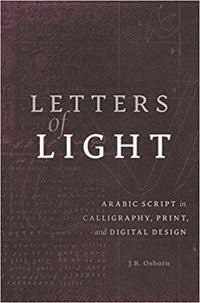CCT's Prof. J.R. Osborn's New Book on the Evolution of Arabic Script
 “J. R. Osborn’s Letters of Light is a fascinating investigation of the development of Arabic scripts over the past millennium and their problematic encounter with Western typography, which sliced expressive lines of cursive writing into individual sorts of cold type. Osborn ingeniously explores how the advent of new computer technologies in the twentieth century has opened a promising future for the design of Arabic scripts that conform to and expand upon calligraphy’s formal and aesthetic traditions.” – Jonathan M. Bloom, Paper Before Print: The History and Impact of Paper in the Islamic World
“J. R. Osborn’s Letters of Light is a fascinating investigation of the development of Arabic scripts over the past millennium and their problematic encounter with Western typography, which sliced expressive lines of cursive writing into individual sorts of cold type. Osborn ingeniously explores how the advent of new computer technologies in the twentieth century has opened a promising future for the design of Arabic scripts that conform to and expand upon calligraphy’s formal and aesthetic traditions.” – Jonathan M. Bloom, Paper Before Print: The History and Impact of Paper in the Islamic World
Read on for the publisher’s book description.
Arabic script remains one of the most widely employed writing systems in the world, for Arabic and non-Arabic languages alike. Focusing on naskh―the style most commonly used across the Middle East―Letters of Light traces the evolution of Arabic script from its earliest inscriptions to digital fonts, from calligraphy to print and beyond. J. R. Osborn narrates this storied past for historians of the Islamic and Arab worlds, for students of communication and technology, and for contemporary practitioners.
The partnership of reed pen and paper during the tenth century inaugurated a golden age of Arabic writing. The shape and proportions of classical calligraphy known as al-khatt al-mansub were formalized, and variations emerged to suit different types of content. The rise of movable type quickly led to European experiments in printing Arabic texts. Ottoman Turkish printers, more sensitive than their European counterparts to the script’s nuances, adopted movable type more cautiously. Debates about “reforming” Arabic script for print technology persisted into the twentieth century.
Arabic script continues to evolve in the digital age. Programmers have adapted it to the international Unicode standard, greatly facilitating Arabic presence online and in word processing. Technology companies are investing considerable resources to facilitate support of Arabic in their products. Professional designers around the world are bringing about a renaissance in the Arabic script community as they reinterpret classical aesthetics and push new boundaries in digital form.
For more, see an excerpt and purchase details on Amazon.
